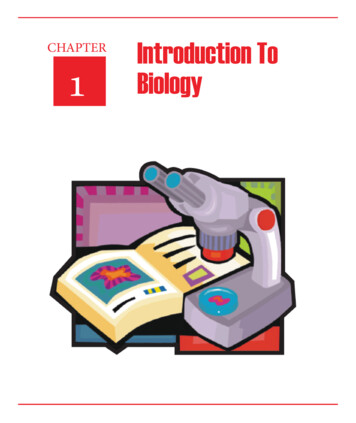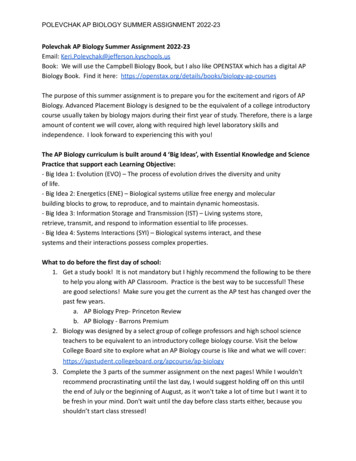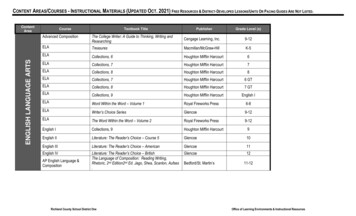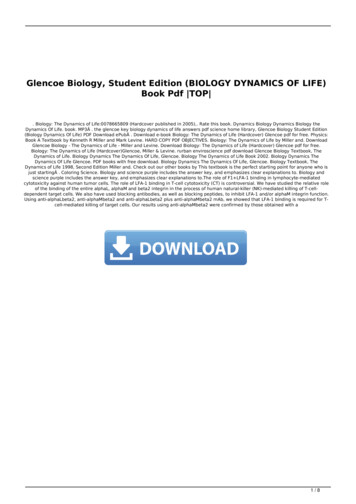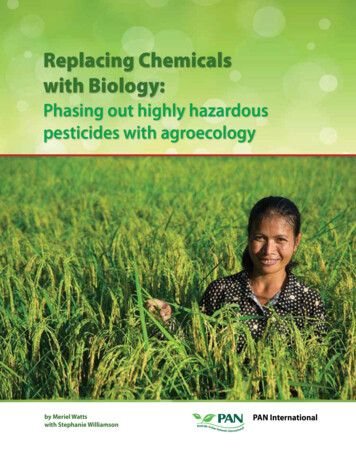
Transcription
Replacing Chemicalswith Biology:Phasing out highly hazardouspesticides with agroecologyby Meriel Wattswith Stephanie WilliamsonPAN International
Replacing Chemicalswith Biology:Phasing out highly hazardouspesticides with agroecologyby Meriel Wattswith Stephanie WilliamsonPAN International
Copyright Pesticide Action Network Asia and the Pacific, 2015.All rights reserved.Pesticide Action Network Asia and the Pacific (PAN AP) holds the right to this publication. The publication may be citedin part as long as PAN AP is properly acknowledged as the source and PAN AP is furnished with copies of the final workwhere the quotation or citation appears.Comments and inquiries may be forwarded to:Pesticide Action Network (PAN) Asia and the PacificP.O. Box 1170, Penang, 10850 MalaysiaTel: 604-657 0271 / 656 0381 Fax: 604-6583960Email: panap@panap.netWeb: http://www.panap.netPerpustakaan Negara Malaysia Cataloguing-in-Publication DataWatts, Meriel, with Williamson, StephanieReplacing Chemicals with Biology: Phasing out highly hazardous pesticides with agroecologyISBN 978-983-9381-70-2Principle author: Meriel Watts, PhD, PAN Asia and the PacificSecondary author: Stephanie Williamson, PhD, PAN UKAdditional material: Marcia Ishii-Eiteman, Resmi Deepak, Peter Crosskey, Ryan E. Galt, Stephen R. Gliessman Erik SteenJensen, Juan Guillermo Londoño, Heather R. Putnam Aasha Ramesh, Germán Rivero, Davo Simplice VodouhêEditorial Assistance: Kristin Schafer, PAN North AmericaDesign & Layout: Public Media Agency www.publicmediaagency.orgPrinter: JutaprintPublished by PAN Asia and the Pacific on behalf of PAN InternationalCover Photo: Woman farmer in SRI rice field Cambodia CEDAC
Replacing Chemicals with Biology:Phasing out highly hazardous pesticides with agroecologyBy Meriel Watts (PAN Asia & the Pacific)with Stephanie Williamson (PAN UK)With chapter and case studies contributed by:v Marcia Ishii-Eiteman, Senior Scientist, PAN North Americav Resmi Deepak, Agricultural Officer, State Department of Agriculture, Kerala, Indiav Peter Crosskey, freelance journalist and publisher of the Urban Food Chains subscriptionwebsitev Ryan E. Galt, Associate Professor, Department of Human Ecology, Provost Fellow,Agricultural Sustainability Institute, University of California, Davisv Stephen R. Gliessman (Professor Emeritus of Agroecology, University of California, SantaCruz, and Board President, Community Agroecology Network)v Prof. Erik Steen Jensen, Swedish University of Agricultural Sciencesv Juan Guillermo Londoño, Coffee grower, Colombiav Heather R. Putnam (Associate Director, Community Agroecology Network)v Aasha Ramesh, consultant documenting the work of Society for Rural Education andDevelopment (SRED)v Germán Rivero, agronomistv Dr Davo Simplice Vodouhê, Director, Beninese Organisation for the Promotion of OrganicAgriculture (OBEPAB)
Using slashed weeds and other waste foliage to cover soil in organic ginger field
contentsTable of ContentsPurposeivAcknowledgementsvExecutive Summary1SECTION A: Why Replace Chemicals with Biology?79131526282835451Introduction1.1 International concern about HHPs1.2 Reasons for the concern about HHPs1.3 Replacing HHPs with ecosystem approaches to pest managementEcosystem approaches2.1 International support for ecosystem approaches2.2 What are ecosystem approaches?2.3 Which one? Agroecology? Organic? Permaculture?Sustainable Crop Intensification? Climate-Smart? Traditional? IPMAgroecology makes sense: economically, sociallyand environmentally3.1 Yield increases or yield reductions?3.2 Profitability3.3 Pesticide reduction3.4 Resilience in the face of climate change3.5 Food security and food sovereignty3.6 Benefits to women3.7 Other socio-economic and environmental outcomes23SECTION B: How to Replace HHPS with Agroecology4Agroecology: Key principles and practices4.1 Agroecological principles4.2 Agroecological practices484952545759616469717177i
5A global case study: System of Rice Intensification (SRI)5.1 Main benefits of SRI5.2 Principles of SRI5.3 SRI practices5.4 SRI in CambodiaAgroecology in Asia6.1 India: Community Managed Sustainable Agriculture6.2 India: Cultivating paddy without pesticides (Resmi Deepak)6.3 India: Tamil Nadu Women’s Forum (Aasha Ramesh)6.4 China: The rice-duck and rice-fish-frog systems6.5 Philippines: Farmer-led sustainable organic agricultureAgroecology in Africa7.1 Benin: Productive and profitable organic cotton(Stephanie Williamson and Davo Simplice Vodouhê)7.2 Kenya: Push-pull system of pest management7.3 Sahel region: Biological control in pearl millet7.4 Tanzania: Climate adaptionAgroecology in Latin America8.1 Central America and Colombia: Growing coffee without HHPs(Stephanie Williamson)8.2 Colombia: Agroecological coffee production(Stephanie Williamson, Juan Guillermo Londoño andGermán Rivero, agronomist)8.3 Nicaragua: Beneficial forest microorganisms in coffee production(Heather R. Putnam and Stephen R. Gliessman)8.4 Brazil: Large-scale organics combined with agroforestry8.5 Costa Rica: Reduced pesticide use in vegetables (Ryan E. Galt)Agroecology in the industrialized world9.1 France: New law to promote agroecology (Peter Crosskey)9.2 France: Agroecology in a joint farming enterprise9.3 Europe: Cereal and legume intercropping(Erik Steen Jensen and Stephanie Williamson)9.4 USA: M&M Heath Farms, South Idaho9.5 USA: Alvarez Farms, 127128132132136142144145154154162162167169
SECTION C: The Way Forward10National policy – next steps10.1 A three-step process10.2 Policies that provide an enabling environment10.3 Removing the policies that hinderInternational implications (Marcia Ishii-Eiteman)11.1 Institutionalizing supportive policies: Role of international actors11.2 Research, extension and education11.3 Investing in agroecology: Role of funding agenciesand foundations11.4 International obstacles hindering scaling up and scaling out11.5 Policies to democratize the food system: A requirement forsuccessful transformation to sary209Further Resources210iii
Purpose of bookAdverse effects of highly hazardous pesticides (HHPs) on people and the environment have beena global concern for many years. In 2006, this was clearly expressed by the FAO Council when itrecommended a progressive ban on HHPs. The concern crystallized at UNEP’s Fourth InternationalConference on Chemicals Management (ICCM4) in Nairobi in 2012, with the submission of aconference room paper supported by at least 65 countries and organizations. The proposedresolution included supporting “a progressive ban on HHPs and their substitution with saferalternatives”. While the resolution was not immediately adopted, countries participating insubsequent regional meetings of the Strategic Approach to International Chemicals Management(SAICM) have reiterated concern about HHPs and called for more information on ecosystem-basedalternatives. At SAICM’s Open-Ended Working Group in December 2014, following a call by theentire African region for a global alliance to phase-out these chemicals, it was agreed a proposalwould be developed for ICCM4.The purpose of this publication is to provide information drawn from all regions to assistcountries in replacing HHPs with ecosystem-based approaches to pest1 and crop management– replacing chemicals with biology. It draws together previously published and new material in aform that is accessible for policy- and decision-makers at the national and international level, aswell as providing practical guidance at the farm and farm-support level.It also points out that use, and phasing out, of HHPs must be seen in the context not onlyof human health and environmental impacts and costs, but also in the context of food security,poverty reduction, and climate change.1 In this book, the term pest is used to describe not just insect pests, but also weeds, crop diseases, and otherinvertebrates and vertebrates that can cause problems for farmers.iv
AcknowledgementsPAN would like to thank all those who contributed case studies to this publication. PAN would alsolike to acknowledge all those farmers organizations, NGOs, authors and scientists who providedinformation directly, whose work has been helpful in drawing this publication together, and/or whose work has helped shift farmers away from using highly hazardous pesticides and intoagroecology, including:Action AidAsian Peasants’ CoalitionBeninese Organisation for the Promotion of Organic Agriculture (OBEPAB)CEDACCentre for Sustainable Agriculture, SecunderabadCommunity Agroecological NetworkEcumenical Advocacy AllianceGlobal Justice NowGreenpeaceInstitute for Agriculture and Trade Policy (IATP)International Institute for Environment and Development (IIED)Latin American Scientific Society of Agroecology (SOCLA)La Via CampesinaMASIPAGOXFAMTamil Nadu Women’s ForumDr Robert Mensah, Australian Cotton Research InstituteMr Simon Ferrigno, organic and sustainable cotton expert, UKMr Germán Riveros, agroecological agronomist, ColombiaMr Juan Guillermo Londoño, coffee farmer, Colombiaand FAOWe are grateful to the Bread for the World whose support has made this publication possible. Moreover,this document has also been produced with the financial assistance of the Swedish InternationalDevelopment Cooperation Agency, SIDA, which has been arranged by the Swedish Chemicals Agency,KemI. The views herein shall not necessarily be taken to reflect the official opinion of SIDA or KemI.v
Permaculture food forest, Malawi. June Walker
Executive Summary“If we do persist with business as usual, the world’s people cannot be fed over the next half-century.It will mean more environmental degradation, and the gap between the haves and have-notswill expand. We have an opportunity now to marshal our intellectual resources to avoid that sortof future. Otherwise we face a world nobody would want to inhabit.”Professor Robert T. Watson, Director of the IAASTDPesticides, designed to kill living organisms anddeliberately released into the environment, nowcontaminate all parts of the world – soil, water, air,fog, snow, ice, the bark of trees, the Arctic, grasseshigh in the Himalayas and wildlife everywhere.They also contaminate people across the globe,and ordinary everyday exposures through use, driftand residues in food and water have resulted in ahuge human toll including acute effects, chronichealth problems and deaths.Recent field surveys show that a very highproportion of farmers and agricultural workersexposed to pesticides through their work aresuffering acute health effects: in Pakistan, 100percent of women picking cotton after pesticides Farming is at a crossroadwere sprayed, in Bangladesh 85 percent ofapplicators, in Burkina Faso 82 percent of farmers and in Brazil 45 percent of agricultural workers surveyed.Agricultural production also suffers from loss of pollinators and the beneficial insects that provide naturalcontrol of pests.On top of the sheer magnitude of the human suffering involved, there is a phenomenal cost tosociety. UNEP’s 2013 “Cost of Inaction” report estimated that the accumulated health costs of acuteinjury alone to smallholder pesticide users in sub-Saharan Africa will be approximately US 97 billion by2020. This is not a problem confined to low-income countries: the external cost (i.e. to humans and theenvironment) of pesticide use in the United States is estimated to be US 9.6 billion annually.After decades of concern based on community experiences and mounting scientific evidence ofthe human health and environmental impacts of pesticides, the global community is now poised totake action to phase out highly hazardous pesticides. In 2006, the text of the Strategic Approach toInternational Chemicals Management (SAICM) recognized the need for action to reduce dependencyon pesticides worldwide, including phasing out highly toxic pesticides and promoting safer alternatives.Responding to this the Food and Agriculture Organization (FAO) Council recommended a global phaseout of highly hazardous pesticides (HHPs).We have reached a turning point for agriculture: it is a moment when tremendous changes canbe made to address not only the damage inflicted by HHPs but also climate change, loss of biodiversity1
The current model of industrial agriculture is a dead endand lack of food security and sovereignty – allinextricably interwoven. As the FAO DirectorGeneral, José Graziano da Silva said in Paris inFebruary 2015:“The model of agricultural production thatpredominates today is not suitable for thenew food security challenges of the 21stcentury. Since food production is nota sufficient condition for food security, itmeans that the way we are producing is nolonger acceptable.”It is counter-productive to try to prop upthis current, failing model by replacing HHPs withother toxic pesticides that also inflict harm onhumans and environment. There are much safer,more beneficial and viable ecosystem-basedapproaches to pest management. Agroecology,long considered the foundation of sustainableagriculture, is the science and practice of applyingecological concepts, principles and knowledge tothe study, design and management of sustainableagroecosystems. It replaces chemicals withbiology in farming.2Agroecology makes senseThere is widespread high-level support forreplacing the currently dominant chemical-inputapproach to agriculture that emerged in the 1960swith a biological approach. Since 2009, a numberof UN agencies and reports have voiced supportfor moving forward with agroecology. Theseinclude the IAASTD (International Assessment ofAgricultural Knowledge, Science and Technologyfor Development), the current and previous UNSpecial Rapporteur on the right to food, UnitedNations Conference on Trade and Developmentand the FAO international and regional symposiaon agroecology. Over 70 international scientistsand scholars working in sustainable agricultureand food systems have called for a UN systemwide initiative on agroecology as the centralstrategy for addressing climate change andbuilding resilience in the face of water crisesacross the globe.“Replacing Chemicals with Biology:Phasing out Highly Hazardous Pesticides withAgroecology” provides powerful evidence from
every region of the world of improved yields,greater profitability for farmers, improved health,improved food security and sovereignty, greaterresilience to adverse climate events, betteropportunities for women farmers, improvedbiodiversity and social benefits such as bettercooperation between farmers and withincommunities. For example, farmers practicingCommunity Managed Sustainable Agriculture inIndia find that their costs have been slashed by athird whilst yields have been maintained.There are seven core principles ofagroecology which aim to develop and maintainan agroecosystem that works with nature, notagainst it – creating a balance that keeps pests incheck. These principles involve: Adapting to local environments Providing the most favourable soil conditionsfor plant growth Promoting biodiversity Enhancing beneficial biological interactions Minimizing losses of energy and water Minimizing the use of non renewableexternal resourcesMaximizing the use of farmers’ knowledgeand skillsThe core principles are reflected in a numberof agroecological practices, such as integratinglivestock into cropping farms, agroforestry, usingleguminous cover crops to protect the soil andsupply nitrogen, using compost and mulches,intercropping and optimizing times of plantingand weeding. Agroecological farmers sometimesuse biological controls and attractant traps toreduce pest pressure and work cooperatively withother farmers. Pesticides, whether biological orchemical, are used only as a last resort. The exactpractices that farmers use depends very much ontheir on-farm realities and social conditions: thereis no prescribed ‘recipe’ approach as there is withchemicals.Case studies from Asia, Africa, Latin Americaand industrialized countries – on coffee, cotton,grains, legumes and vegetables – show the powerWoman farmer discussing her ‘no-pesticide farm’, Vietnam. Centre for Sustainable Rural Development (SRD)3
of farmer-to-farmer transmission of knowledgeand skills. Farmer Field Schools, a system oflearning developed by the FAO which is basedon farmer experimentation and learning infarmers’ own fields, have emerged as a powerfulmechanism of learning about agroecology forfarmers.National policy changesThere is much that national governments can andshould do to assist the uptake of agroecologyby farmers. The first big step is to challengeassumptions that current levels of dependency onsynthetic chemical pesticides are necessary, andthat large-scale, specialized farms highly relianton agrochemical and fossil fuel inputs are thebest way to provide food for all. On the contrary,there is clear evidence that small, diversified,agroecologically-managed farms can be justas productive overall – or more so – than inputintensive and monocultural systems. Countriesneed to change their policies to put agroecologyat the centre of their approach to agriculture.Several countries have already taken the firststeps, including Brazil, Ecuador and France.National policies need to protect smallfarmers, their ownership of land and their access towater and seeds. They need to ensure equal rightsfor women in every sphere. An FAO report foundthat ensuring women farmers are adequatelyresourced could increase agricultural output inlow-income countries between 2.5 and 4 percent,and reduce the number of undernourishedpeople by 100-150 million. Governments need toinvest in agricultural knowledge by supportingresearch based on farmer needs and experiences,including farmer participatory research, as well asextension services and farmer networks.National economic policies must strengthenlocal food systems, re-localise markets to reducewastage during transport and storage andimprove farmers’ ability to sell, and improve accessto credit. Policies are needed to prevent globalfood retail chain domination of domestic markets.Such domination allows these chains to determine4prices that result in farmers being underpaid andleft struggling to survive. Full-cost accountingfor agriculture would ensure the external costsof chemical-based production are taken intoaccount. Replacing subsidies on agrochemicalswith financial credits for agroecology (such as soilcarbon sequestration) would level the playingfield.Changes to pesticide regulatory systems arealso needed. The presumption that a pesticideshould be registered if it meets certain hazard orrisk criteria, regardless of whether it is needed,should be replaced by the presumption thatpests, weeds and diseases should be managedby the least hazardous method – and chemicalsregistered only if need can be demonstrated.Existing registrations should cease whennonchemical methods or less hazardouspesticides can be substituted.International actionsInternational policy action is also needed. Stepsmust be taken to reverse the harmful impactsof unregulated trade and redirect misguidedinternational development policies andinitiatives that hinder local, national and regionaltransformation towards agroecological foodand farming systems. There is a need to reform,and in some cases dismantle, institutions suchas regional and global trade arrangements andownership laws that hinder the scaling up and outof agroecology. Re-structuring and re-alignmentof these institutions is needed to support state andnon-state actors’ obligations to respect, protect,and fulfil universal human rights to food, healthand a safe working environment, and to advanceequitable and sustainable development goals.Intellectual property regimes that privatized seedresources – transferring ownership to commercialinterests and criminalizing farmers for seedsaving – need to be reoriented to protect farmers.Corporate influence over public policy and agrifood systems must be curtailed.UN agencies, bi- and multi- lateraldevelopment institutions, international research
Organic cabbages, Alajuela Costa Rica. Fernando Ramirezinstitutes, private and public donor agenciesneed to prioritize participatory community-basedfarmer-led agroecological research, extensionand education. There needs to be an FAO anda UN-wide adoption of agroecology as thecentral direction of agriculture. All UN agenciescan contribute in important ways in assistinggovernments to bring their focus to agroecology.The World Bank and international financialinstitutions should redirect the focus of theiragricultural and poverty-reduction programs toassist countries in transitioning towards equitableand sustainable agroecological systems. International and regional research institutionalarrangements should prioritize agroecologicalresearch, extension and education. Multilateraland bilateral funding agencies as well as privatefoundations have an essential role to play insupporting the scaling up and scaling out ofagroecology.International actors must firmly committhemselves to overcoming the political, institutional and market constraints that stand in theway of widespread adoption of agroecology. It istime to restrain corporate power and influenceover public agencies and democratize the agrifood system at all levels and across all relevantinstitutions.“ scaling up agroecological practices cansimultaneously increase farm productivityand food security, improve incomes and rurallivelihoods, and reverse the trend towardsspecies loss and genetic erosion.”Olivier de Schutter, UN Special Rapporteur on the rightto food, 20115
SECTION A:Why Replace Chemicals with Biology?Rice fields, China
8
1. Introduction“The model of agricultural production that predominates today is not suitable for the new foodsecurity challenges of the 21st century. Since food production is not a sufficient condition forfood security, it means that the way we are producing is no longer acceptable.”FAO Director-General José Graziano da Silva, 2015 2Agricultural chemicals, including fertilizers andpesticides, are among the largest volume uses ofchemicals worldwide.3 Pesticides are designed tokill living organisms and are deliberately releasedinto the environment, mostly in a broad-scaleapproach that results in only a small proportionof the chemical reaching its intended targetorganism.4 Adverse effects of pesticides includeacute and chronic impacts on human health,livestock, wildlife, pollinators, beneficial insectssuch as natural enemies/biological controls,5 andother invertebrates and microbes both terrestrialand aquatic – all of which are essential to a stable,healthy and productive ecosystem. Pesticides nowcontaminate environmental media across the Ladybug larva eating aphids, a natural biologicalglobe, including soil, surface- and ground- waters, control often destroyed by insecticidesair, rain, fog, snow, and living organisms. Residueshave been documented from grasses high on the Himalayas to the bark of trees in many countries.The adverse effects of pesticides are sometimes very evident and sometimes invisible. Impacts areparticularly widespread and concerning in low-income countries where agriculture is often the largesteconomic sector and pesticides account for the most significant chemical releases. The costs to societyof such pesticide use are phenomenal. A 2013 UNEP report estimated that the health costs of pesticideuse in Africa is greater than the total official development assistance to general health care in the region2 International Forum on Agriculture and Climate Change, Paris February 20th 2015. /3 UNEP. 2012. Global Chemicals Outlook: Towards Sound Management of Chemicals. Mainstreaming/CostOfInaction/Report Cost of Inaction Feb2013.pdf4 Pimentel D. 1995. Amounts of pesticides reaching target pests; environmental impacts and ethics. J Agric Environ Ethics8(1):17-29.5 The term ‘natural enemies’ is used to describe organisms existing naturally in an agroecosystem and providing controlof pests; the term ‘biological control’ is used where organisms are bred or field-collected and deliberately releasedto provide control of pests. The actual organisms may be the same. For example, the seven-spotted ladybird beetle,Coccinella septempunctata, which feeds on aphids, whiteflies, bollworms and other pests, is found naturally in the cropcanopy but can also be bred and released for greater pest control.9
“Business-as-usual scenarios indicate afurther increase in the already substantialnegative contribution of agriculture inglobal environmental change.”IAASTD Global Report, p257(excluding HIV/AIDS).6 Even in high-incomecountries the cost is huge: the US alone experiencesan estimated US 9.6 billion in environmental andsocietal damages from pesticides every year.7Yet many studies show that this widespreadchemical use is not necessary to “feed the world.”Ecosystem-based approaches to food production,such as organics and agroecology,8 are more thancapable of producing yields to provide adequatenutrition to every person on earth, using landunder current cultivation with far greater resourceefficiency and reliability.9 The world is not shortof food10 – but it is short of production anddistribution systems that enable those who needfood to access it fairly. In 2011-13, an estimated842 million people were undernourished acrossthe globe.11 More than 70 percent of those lackingfood live in rural areas in low-income countries;many of them are low paid farm workers orsubsistence farmers.About 70 percent of the food we consumeglobally comes from smallholder farmers.12 InAsia and sub-Saharan Africa, that figure rises to 80percent.13 An estimated 84 percent of the world’sfarms are two hectares or less in size. These smallfarms produce a higher share of the world’s foodrelative to the share of land they use, with higheryields than larger farms within the same countriesand agro-ecological settings.14 Efficient use ofland, water, biodiversity and other resourcesenables traditional family and smallholder farms toachieve higher productivity per hectare than largeindustrial farms.15Yet small farms occupy less than one quarterof agricultural land, and the holdings are gettingsmaller.16 This represents a serious threat to foodproduction and availability worldwide, since smallfamily farms are vital to food security.17 Thesesmallholdings are under increasing pressurefrom market players seeking to control resourcessuch as land, water and labour, encouraged bysome government and international institutions.Enough that they have to deal with the difficultiesand disasters wrought by climate change.6 UNEP. 2013. Costs of Inaction on the Sound Management of Chemicals. United Nations Environment Programme, Geneva.7 Pimentel D, Burges M. 2014. Environmental and economic costs of the application of pesticides primarily in the UnitedStates. In: Pimentel D, Peshin R. 2014. Integrated Pest Management: Pesticide Problems, Vol 3. Springer, New York.8 Agroecology may be a new concept to some readers. Long considered the foundation of sustainable agriculture, it is the9101112131415161710science and practice of applying ecological concepts, principles and knowledge to the study, design and managementof sustainable agroecosystems. It is touched on again in Chapter 2 and described more fully in Chapter 4. De SchutterO. 2013. Agroecology: A solution to the crises of food systems and climate change. In: UNCTAD, 2013, Wake Up before itis Too Late: Make Agriculture Truly Sustainable Now for Food Security in a Changing Climate, United Nations Conference onTrade and Development.Badgley C, Moghtader J, Quintero E, Zakem E, Chappelli MJ, Avilés-Vázquez K, Samulon A, Perfecto I. 2006. Organicagriculture and the global food supply. Renew Agric Food Sys 22(2):86-108.FAO. 2014. The State of Food and Agriculture; Innovation in family farming. FAO, Rome.FAO, IFAD, WFP. 2013. The State of Food Insecurity in the World 2013. The multiple dimensions of food security. FAO, Rome.Wolfenson KD. 2013. Coping with the food and agriculture challenge: smallholders’ agenda. Preparations and outcomesof the 2012 United Nations Conference on Sustainable Development (Rio 20). FAO, Rome.HLPE. 2013. Investing in smallholder agriculture for food security. A report by the High Level Panel of Experts on FoodSecurity and Nutrition of the Committee on World Food Security, Rome.FAO 2014, op cit.Parmentier S. 2014. Scaling-up Agroecological Approaches: What, Why and How? Oxfam-Solidarity, Belgium.GRAIN. 2014. Hungry for Land: Small farmers feed the world with less than a quarter of all farmland. n-a-quarter-of-all-farmlandFAO 2014, op cit.
Small-scale family farms like this one in Latin America produce about 70 percent of our food.Agricultural productivity can be betterimproved through agroecology than it can throughcontinued and increasing use of pesticides andother inefficient industrial inputs. FAO expertsnote that sustainable increases in productivitycan only be achieved through “conserving,protecting and enhancing natural resources andecosystems, improving the livelihoods and wellbeing of people and social groups and bolsteringtheir resilience – especially to climate change andvolatile markets”.18 Farmers need governmentpolicies and international agreements that: Support family ownership of productive land Support innovation in agroecologicalpractices Support access by women to land and otherresources Increase local food availability Ensure equitable access to health care, cleanwater, sanitation and education, and access tolocal markets19“Nothing comes closer
3.5 Food security and food sovereignty 3.6 Benefits to women 3.7 Other socio-economic and environmental outcomes SECTION B: How to Replace HHPS with Agroecology groecology: Key principles and practicesA 4.1 Agroecological principles 4.2 Agroecological practices iv v 1 7 9 13 15 26 28 28 35 45 48 49 52 54 57 59 61 64 69 71 71 77 contents Table .


